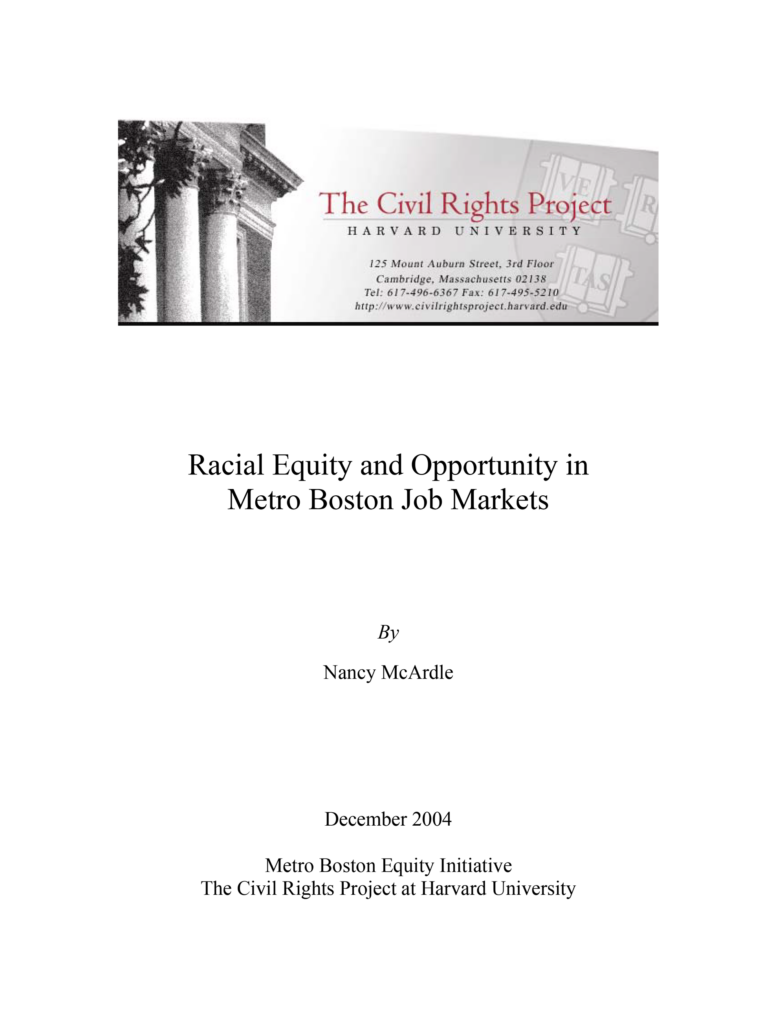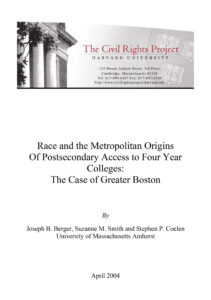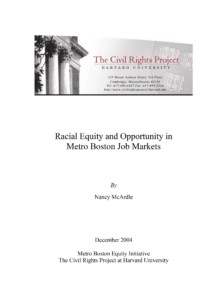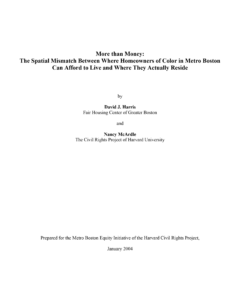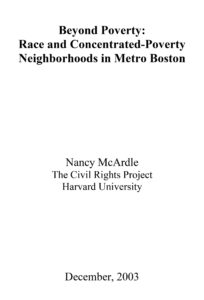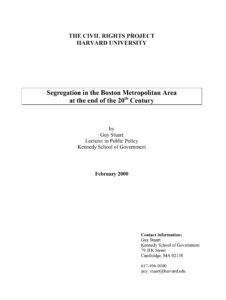Executive Summary
People of color make up a vital and growing part of Metro Boston’s workforce. They face substantial challenges, however, in obtaining employment (especially in faster-growing and higher-paying sectors), in accessing locations of rapid job growth, and in earning a livable income. Latinos and blacks face the greatest hurdles, yet certain Asian populations struggle as well—especially those with less education and those working in the shrinking manufacturing sector or low-paying service jobs. Previous work by the Metro Boston Equity Initiative of the Civil Rights Project at Harvard University has examined the related challenges of segregated housing patterns and unequal educational opportunities faced by racial and ethnic minorities in Metro Boston. This paper takes the next logical step—exploring how segregated living patterns result in limited minority access to fast growing job areas and how unequal educational opportunities and high drop-out rates handicap minorities in a labor market where the gap between the economic returns to those with education and skills and those without is widening.
Metro Boston’s workforce is becoming more racially and ethnically diverse. Over the 1990s total employment growth was just 4%, but the number of Latino workers grew by over 50%, and the number of Asian workers grew by more than 70%. At the same time, the number of white workers declined slightly. Foreign immigration is the main driver behind minority employment growth. As of 2000, over 80% of employed Asian workers and over half of Latino workers were immigrants. Nevertheless, the Metro Boston workforce remains overwhelmingly (85%) white–the third whitest workforce among large metro areas. If current trends continue, the Metro Boston workforce will be about three quarters white by 2020, roughly matching the composition of today’s entry-level workforce (age 20-30.) However, given the movement of the large, mostly white baby-boom generation toward retirement ages, it is likely that the future workforce will be even less white than current trends suggest.
Consistent with national spatial patterns, job growth continues to move outward, away from the areas of greatest minority population growth. The large majority (71%) of Metro Boston’s net job growth over the 1990s occurred in the outer suburbs (suburban areas beyond Route 128.) While all of net white population growth occurred in these outer areas, only 18% of Latino, 24% of black, and 30% of net Asian population growth occurred there. In contrast, only 4% of Metro Boston’s net job growth took place in the urbanized satellite cities (places such as Lowell, Lawrence, Brockton, and New Bedford), but 56% of Latino, 48% of black, and 33% of Asian net population growth occurred there. While people of color are finding jobs in suburban locations to a greater degree than in the past, if current trends persist, minority residential patterns and the geography of job growth will continue to diverge.
The spatial mismatch between where people of color live and where jobs are growing fastest makes access to transportation especially important in gaining and maintaining employment. Generally speaking, the ability to work in the outer suburbs depends on access to a reliable car. Yet, people of color are much less likely than whites to live in a household with a vehicle available. Almost a third of black and Latino and a fifth of Asian households have no vehicle access, versus 11% of white ones. Even in the suburbs, 1 in 7 black and 1 in 6 Latino households lack vehicle access. People of color, and blacks especially, are much more reliant on public transportation as a means of commuting to work than are whites. This pattern is partially explained by the much greater concentration of blacks in the City of Boston, where public transportation is most accessible. Yet, the disparity prevails within geographic sub-regions as well, particularly in the suburbs. Even in the outer suburbs, about 12% of black workers and 7% of Asian workers rely on public transportation for their commute, compared to 4% of whites. Roughly 10% of suburban Latinos rely on public transportation. Relative to other groups, suburban Latinos disproportionately rely on carpooling, as do those Latinos living in the urbanized satellite cities.
Metro Boston’s employment base is shifting not only in terms of location, but also in terms of occupation—a shift primarily from manufacturing to services. Over the 1990s, almost 72,000 manufacturing jobs were lost–close to one sixth of all manufacturing jobs in the metro. The majority (58%) of these losses occurred in the urbanized satellite cities, which lost close to a third of their manufacturing base. In almost all locations, the service sector added the most jobs and grew at the fastest rate (34%). The loss of manufacturing and production jobs is especially problematic for Latinos. As of 2000, Latinos were twice as likely as the general population to work in the production, transportation, and material moving occupations, occupations that generally require less English language fluency. Unlike most Asians, blacks and Latinos are over-represented in lower-paying service jobs, relative to their share of the total workforce, and greatly under-represented in professional and technical jobs. Thus, as of 2003, Latinos had the highest rates of poverty in Metro Boston (27% vs. 6% for the non-Latino white population.)
People of color are more disconnected from the workforce and from education than are whites. Unemployment rates for Metro Boston’s blacks and Latinos are well over twice as high as for whites. Particularly troubling are the relatively high shares of Latino young people who have no high school diploma, yet are neither enrolled in school nor working. Over ten percent of Latinos ages 16-19 fall into this category–almost 12 percent in the satellite cities. High school graduates have lower unemployment rates for all racial groups, and a diploma is essential as a gateway to higher education. For example, the unemployment rate of young (aged 25-44) black men without a diploma in 2000 was 13.5%. That rate dropped to 9.7% for high school graduates and 3.5% for those with post-secondary education. Similarly, Latino women without a diploma earned $18,000 per year in Metro Boston in 1999 while those with a diploma alone earned $20,000 and those with further education earned $28,000 annually. As the economy increasingly rewards workers with higher skills, college is even more crucial to earning a livable income. Relatively high levels of dropping out put minority youth at risk of criminal activity and imprisonment, and having a criminal record is increasingly a barrier to employment.
Employment discrimination, while less blatant than in the past, and the perception of discrimination also still remain as significant barriers for workers of color. A recent poll of 400 blacks and Latinos in Metro Boston commissioned by the Harvard Civil Rights Project revealed that over one in five African Americans (21%) and one in six (17%) Latinos reported that they were discriminated against at work during the past year because of their race/ethnicity. Almost a third of blacks (31%) and 15% of Latinos reported that they were denied a job they applied for in Metro Boston over the past decade because of their race or ethnicity.
After more than three years of sputtering, the employment outlook in Massachusetts is once again brightening, and it is likely that minority populations will continue to account for the vast majority of labor force growth. Lowering the hurdles that loom for these workers will benefit not only their families and communities but the Metro Boston economic engine as well. Specifically, to promote equity and opportunity for workers of color in Metro Boston we need to:
Reduce barriers that keep people of color from living in job growth areas
- Produce more affordable housing in outlying, high employment growth areas.
- Provide information about non-traditional destinations to homeseekers of color and increase the number and reach of realtors who work with minorities.
- Vigorously enforce Fair Housing laws, with monies allocated for fair housing testing and education.
Develop employment opportunities where workers of color already live
- Develop good-paying jobs in more urbanized areas, particularly many of the satellite cities that have experienced the greatest job losses.
- Take advantage of the existing workforce, reduce traffic congestion and its associated environmental impacts by creating more centralized jobs as a critical component of any “smart growth” strategy.
Facilitate transportation to job sites for workers who live at a distance
- Whether through fixed route services or, more flexibly, subscription taxi, van services, or short term rentals–the public sector, employers, and non-profits must continue to strive to connect people with employment opportunities.
Promote quality education, foster inter-racial contact in schools, and retrain workers in some manufacturing sectors
- Closing the achievement gap will likely take a multi-pronged effort including more equitable funding, early childhood intervention, smaller classes, and greater parent involvement. However, the substantial segregation of students of color in concentrated poverty schools must also be challenged. Many students of color are segregated into high-poverty schools that have trouble obtaining the best teachers, have less challenging curriculum, and have higher drop-out rates.
- As society becomes more multi-racial, the ability to interact successfully with co-workers and clients of different backgrounds becomes more important. Plans that facilitate integration, such as METCO, are needed to encourage interaction between youth of different races, leading to more successful and harmonious workplaces.
- Given the importance of immigrants to the metro’s workforce, it is necessary to increase funding and reduce waiting lists for English, literacy, and GED training, and workforce development.
- Support retraining for those in shrinking manufacturing sectors, either into higher-skilled technology manufacturing or more skilled services.
Actively support workers of color and challenge workplace discrimination
- Encourage programs, such as those run by The Partnership, that support professionals of color.
- Enforce fair employment laws to fight employment discrimination and unfair labor practices.
The Metro Boston Equity Initiative is devoted to analyzing race relations and racial equity issues not simply in the city of Boston, but across the entire metropolitan region. Although greater Boston still has a large white majority and suburban sectors with very little diversity, immigration of Latinos and Asians is driving the region’s growth, and much of this population increase is taking place well outside of the city limits.
In compliance with the UC Open Access Policy, this report has been made available on eScholarship:
